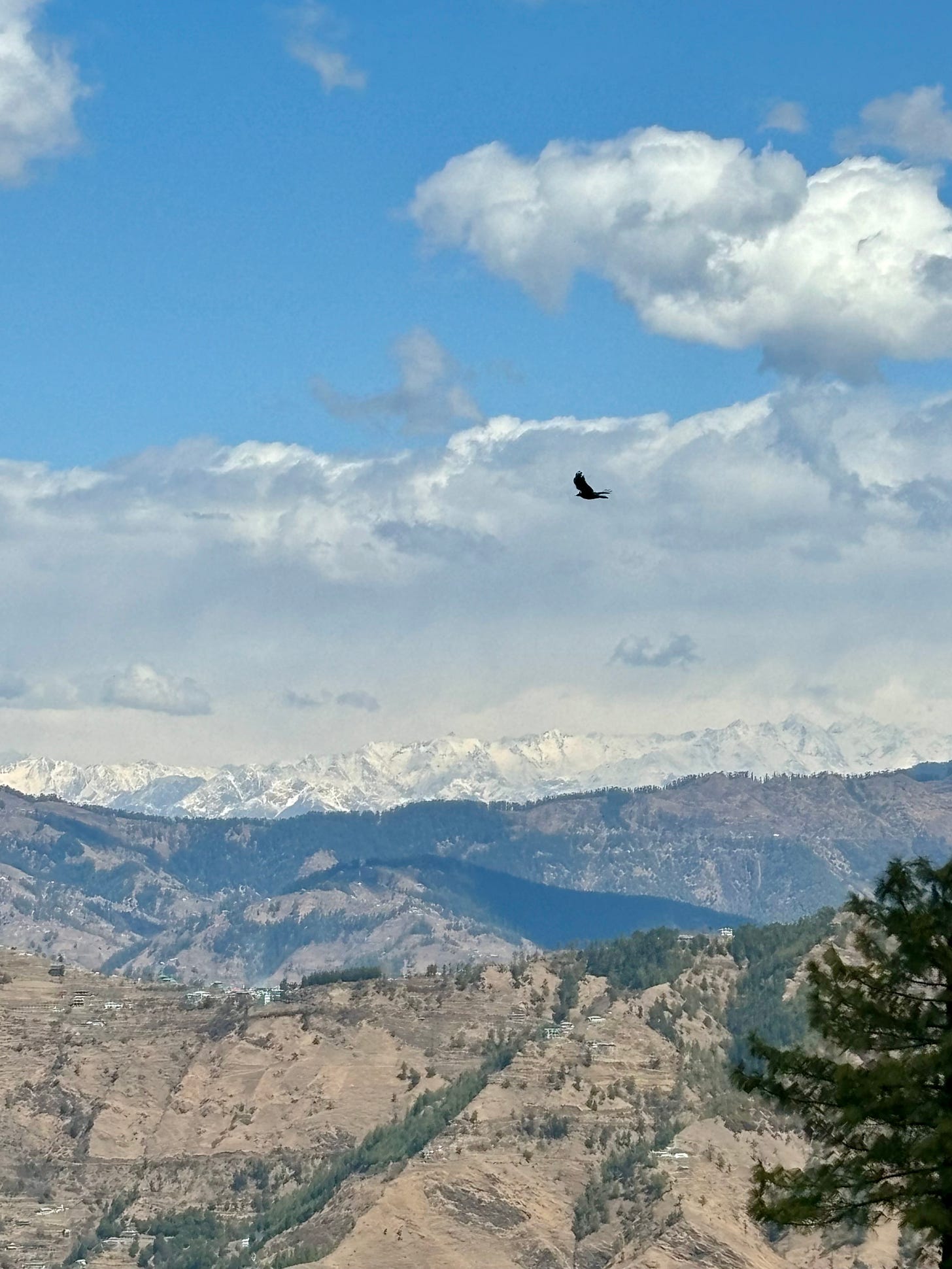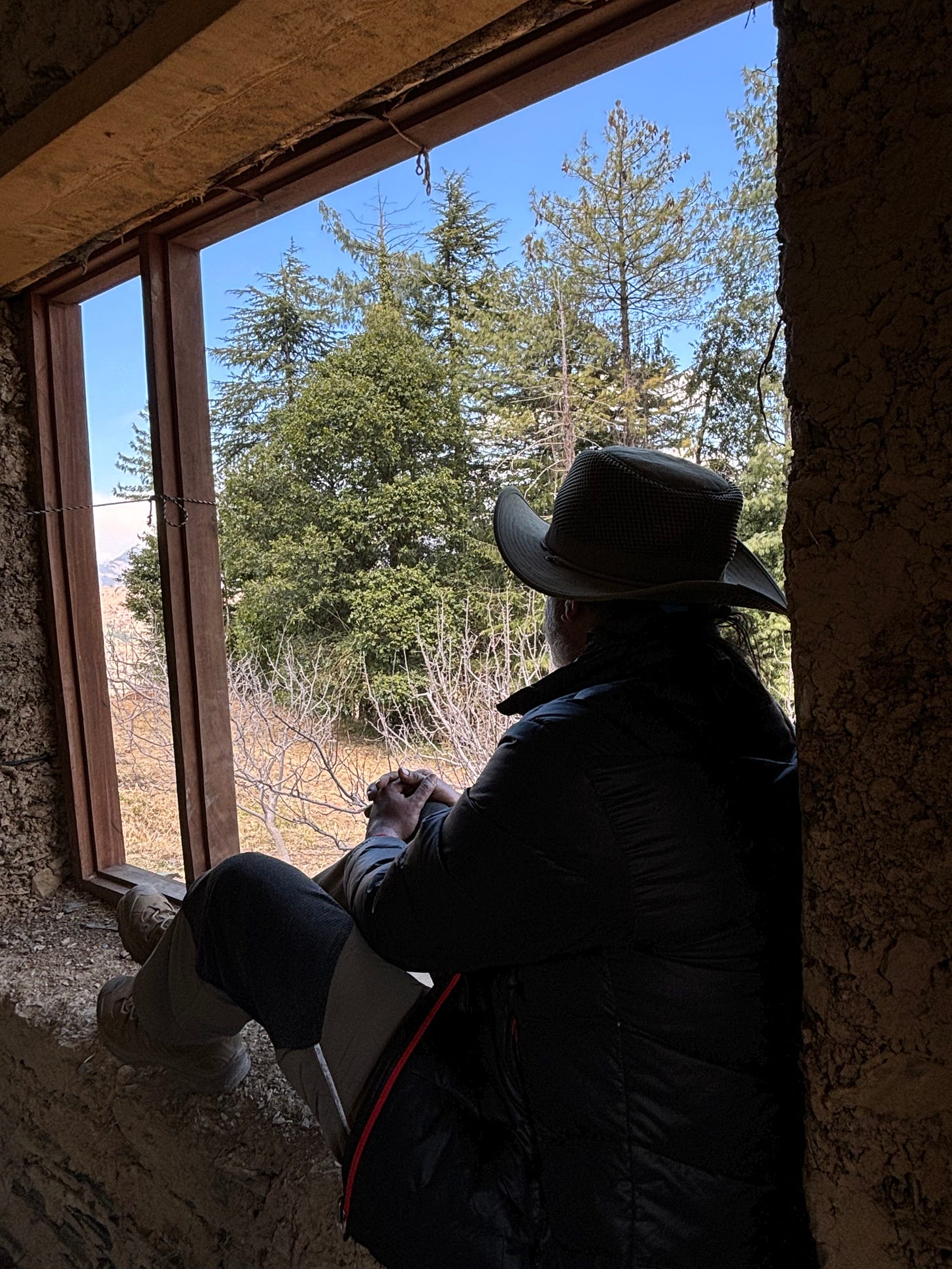In many ways, my partner and I are as opposite as opposites get. We also work brilliantly together for this reason: he thrives in chaos, and my anxiety response is to make endless spreadsheets. We both need the other.
We are deep in the midst of our most ambitious, audacious creative project yet: We are building a retreat and residency space in the Himalayas. We’ve run a campsite together for the last 4 years, and a cafe for 2, so we know something about hosting and food and event planning, but this one is a whole new beast. We have leased a gorgeous piece of apple orchard, nestled among Deodar forests and with views of the snow capped higher Himalayas, for a period of twenty years— long enough to dream, to build, to grow something real. It’s the opportunity of a lifetime, a possibility of realising a dream we’ve both had in different ways. He loves hosting people; I love designing creative events and holding spaces. We get to do both together here.
In the meantime, of course, it’s truckloads of work. We decided to go all in with this dream — to build something in the mountains we both call home, and yet have it be as inclusive and wheelchair accessible as possible; to build a space that feels warm and relaxing and luxurious even, but also to be as sustainable as possible by building in mud and local stone; to design simultaneously for privacy and community, rest and adventure, wonder and groundedness. We have had to constantly consult so many people, pick so many brains and hearts: the Nepali Gorkha workers in Himachal who are amongst the only ones who still know how to build in mud, our landlord and neighbour who helps us understand wind and snow patterns so we can build doorways that are not constantly bring blocked, a geological consultant who helped us understand the contours of our hillside so we can harvest rainwater and make sure not to block natural water channels as we build, the woodworker next door who helps us choose the right wood for our doors and windows, a friend who works in disability and inclusion so that we can make our space genuinely accessible despite all the limitations of constructing in the mountains, two other friends who have better business brains than we do and are helping us plan for financial sustainability, yet another friend who is completely brilliant at communications and outreach, my architect mother for small and big decisions about our floor plans, a big pile of books about designing for community, an environmentalist friend on permaculture and caring for our apple trees without chemicals, and so many, many folks who will come out here to host their workshops or retreats and have thoughts about the space that would most enable them. This isn’t even an exhaustive list, and the process of outreach, absorbing, and creating based on these inputs has been simultaneously so enriching and so exhausting.
So I try to pack it all into big mindmaps and detailed spreadsheets, while my partner packs it all into work on the ground, making sure for example that the electrician understands the placement of the Braille lettered panic button in the washroom and lays the line for it before the tile work begins, and the mason understands why the wheelchair door needs floor springs or sliding channels, and the rainwater tank is at the right slope. I am lost in the ever-changing reality of things that come up on the ground; he is lost in the detailed plans I make on paper. We both need the other.
I wonder sometimes about how I got this way— about why I need to plan so much, even when I know my plans are going to be upended. I trace at least part of it to growing up with major illness: my eyes are still fickle, but while I was in school, they were completely unpredictable. I never knew if I would be able to prepare for an important test, or do my homework the day before it was due, and I certainly couldn’t count on my teachers understanding that I simply could not have opened my eyes the previous day, so from a very young age, I started planning ahead. Even today, if I know that I have an important deadline on the 30th of the month, I will put it into my calendar as the 15th of the month, panic about it from the 10th, but then get it done ahead of time. When so much about my body and how it will work on certain days feels uncertain, there is something reassuring about being able to plan, to make spreadsheets, even at the times when I know it’s only an illusion of control.
The flip side, of course, is that I’m totally thrown when things don’t go according to plan, especially when it’s for reasons I cannot even pretend to control by just staying up later or working harder— things like unseasonal rain or snow halting construction, one of the workers falling off an apple tree and needing to rest (yes, it happened), folks going home for important festivals and then getting stuck in the village because of an earthquake (yes, it also happened), water or electricity cuts halting construction, the slope of the land just too unforgiving to allow as much accessibility as I dreamed of. I’m learning to breathe through this, but I’d be lying if I didn’t acknowledge the ways my brain buckles under the stress of not knowing.
My partner thrives in it, though. He has been a fauji for nearly 30 years, and his crisis response training, his just-in-time training, kicks in. I’m regularly amazed at how unfazed he is by all of this, how able to just keep pushing through and getting things done despite snow and hail and injured workers and erratic supplies and a phone that buzzes constantly all day— just as he is regularly amazed at how many ideas and possibilities I can organise on my screen. He is learning to maintain an accounts spreadsheet, to research access path slopes, to measure out doors and windows before ordering them. I am learning to breathe through chaos. We both need to learn.
Of all the creative partnerships I’ve participated in, this one works for the same reasons it frustrates: we work so differently, I with my head first, hands later, he with his hands first, head later. We learn, we grow, and we manage to create, somewhere between the plans and the chaos, the perfectionist ideal and the ground reality— because, ultimately, we are both in it with whole, entire hearts.
PS: I’m going to share more about what we are doing as we move further, but in the meantime, if you know anyone looking to host retreats, workshops, trainings, or organisational off-sites in the Himalayas, do please shout out to me! I would love to design them together!






sending all the love and luck to you. can't wait to see what you make this space!
I see your wonderful dream taking wonderful forms in reality! My best wishes!:-)